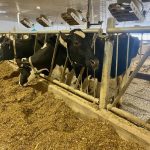Western Canadian feeder cattle prices were steady to $2 per hundredweight (cwt) lower in comparison to week-ago levels. Many feedlots are running on skeleton crews through Christmas and New Year’s and they don’t want to be processing large numbers at this time.
Auction market numbers were lower and the market was characterized by non-feature small groups of feeder cattle. In central Alberta, a group of 25 run-of-the-mill black-and-red-cross steer calves averaging 640 pounds sold for $150/cwt. Feedlot Alley in southern Alberta saw 800- to 900-lb. steers trade in the range of $125-$135/cwt. Alberta packers were buying cattle in the range of $114-$116/cwt, down $2-$3/cwt from a week earlier.
Read Also

U.S. grains: Soybeans, corn fall on harvest pressure
U.S. corn and soybean futures were lower on Monday in choppy trade, pressured by the expanding Midwest harvest of both crops, but uncertainty about quarterly government stocks data due on Tuesday kept a floor under prices, analysts said.
Looking at the year in review, feeder steers weighing 750 lbs. are approximately 20 per cent higher than last year; fed cattle are also 20 per cent above December 2010 while wholesale beef prices are approximately 17 per cent higher relative to year-ago levels. Ground beef has increased by 17 per cent over the past 12 months and higher-end cuts are up approximately 14 per cent. We need to see an increase in consumer income and spending to support a higher price structure in 2012.
U.S. feedlot placement numbers throughout the fourth quarter have been larger than trade expectations. This should result in lower available supplies in the first quarter of 2012 as feeders were marketed sooner than normal.
The live and feeder cattle futures market appears to be incorporating a risk premium due to the uncertainty in beef production. Adverse weather in the U.S. southern Plains is also adding stress to cattle which could result in lower marketing weights. I’m looking for feeder prices to be $3 to $5 higher on average by the end of January.















